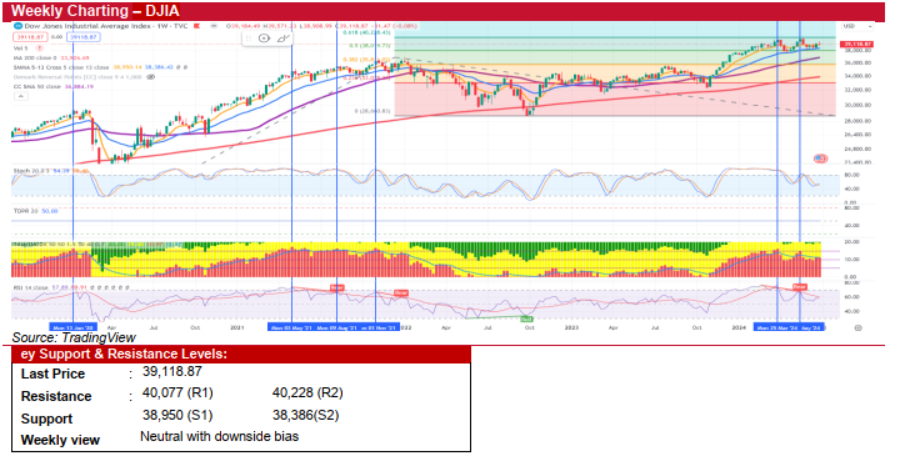Kenanga Research & Investment
Weekly Technical Highlights – Dow Jones Industrial Average (DJIA)
kiasutrader
Publish date: Mon, 01 Jul 2024, 09:27 AM
Dow Jones Industrial Average (DJIA)
- The S&P 500 posted a slight weekly decline, while the NASDAQ saw a modest rise, both remaining near record highs. The DJIA fell slightly but stayed above the 39,000 level, about 2% below its record from six weeks ago. YTD, the S&P 500 is up 14.5%, trailing the NASDAQ's 18.1% gain but well ahead of the DJIA's 3.8% increase which surpassed analysts' initial expectations. Positive expectations are building for the upcoming earnings season which opens in mid-July, with analysts predicting an average earning increase of 8.8% YoY for S&P 500 companies, marking the fourth consecutive quarter of growth.
- Looking ahead, US markets will close on July 4 for Independence Day, leading to light trading volume during the holidayshortened week. Focus will shift to general elections in France and the UK, Europe’s two largest economies. Additionally, the Fed will release its June FOMC minutes on July 4, and a monthly labour market report is due on Friday. These events are expected to influence market sentiment this week.
- Technically, the DJIA has formed a 'doji' candlestick pattern, indicating market indecision in the near term. Despite closing above its 5-week SMA at 38,950, divergent weekly stochastic and RSI indicators suggest an unfavorable risk-reward ratio.
- We expect the market to trade sideways with increased volatility towards the end of the week, likely leaning to the downside. Unexpected general election results from France and the UK, disappointments from key economic data, or an AI sector valuation reset could push the index to re-test the 5-week SMA at 38,950 and the crucial 13-week SMA at 38,386. Conversely, continued bullish momentum in tech could drive the index to test its all-time high of 40,077 and potentially reach 40,228.
Source: Kenanga Research - 1 Jul 2024
More articles on Kenanga Research & Investment
Bond Weekly Outlook - MGS/GII likely to rise amid ongoing US economic resilience
Created by kiasutrader | Nov 22, 2024
Discussions
Be the first to like this. Showing 0 of 0 comments



















